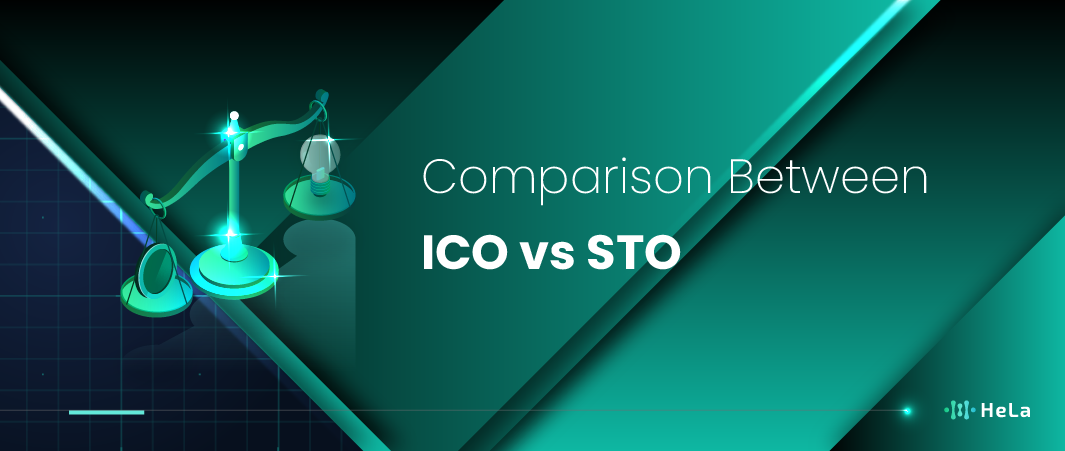ICO vs. STO: What Are The Differences — in the ever-evolving world of cryptocurrency, understanding the differences between Initial Coin Offering (ICO) and Security Token Offering (STO) is crucial for making the right decisions. These two methods offer different approaches to raising funds, with ICOs often attracting new projects due to their faster and cheaper process, albeit with higher risks. On the other hand, STOs provide greater security as they are regulated as securities, offering stronger legal assurances for investors. This article will delve into how these works, the benefits they offer, and the risks that need to be considered.
If you’re looking to determine which option is better suited for your investment or business goals, understanding the differences between ICOs and STOs is essential. ICOs present opportunities for high returns with equally high risks, while STOs offer more stability and security with strict regulations. By reading this article, you’ll gain comprehensive insights that will help you choose the most suitable method for your needs in the world.
What is ICO?

An Initial Coin Offering (ICO) is a crowdfunding mechanism that is employed by most start-ups or projects with an attachment to blockchain systems to help them in raising capital. In a nutshell, an ICO can be compared to an IPO in the stock market, where instead of offering shares in a company, a project offers tokens. These tokens can represent a wide variety of items, such as a loan of form in the future product or service, or even the right to a portion of the profits of the project. Usually, such tokens are given through the blockchain system, which makes them transparent and reliable. This was the case because ICOs presented the opportunity for projects to get funding relatively faster than in an IPO since it doesn’t involve a rigorous legal procedure.
The ICO procedure starts when a project come out with the white paper as an announcement of its intention to launch a funding campaign which indicates the project, its purpose, the amount of tokens it will sell and how the raised funds will be utilized. Investors can then buy tokens using other cryptocurrencies such as Bitcoin or Ethereum or even fiat money in some instances. The amount of tokens sold and the price of each token is typically fixed in advance, but may be adjusted based on the market conditions. This way, investors expect the tokens they buy to become more valuable as the project progresses, so they can then sell tokens for a profit.
However, ICOs still pose a lot of risks. This has made it difficult for many investment projects to deliver on their promise to investors or, most unfortunately, they are outright scams. It becomes very important that investors should be very careful in selecting which projects to fund. Furthermore, volatility is rife in the world of cryptocurrency, meaning that tokens could plummet in value and thus heavily cost investors. Thus, it should be noted that investing in an ICO involves risks, so investors should study all aspects of the project, such as the team behind it, the technology, and the market demand.
Even so, the risks that have been highlighted make ICOs a versatile instrument that can help decentralize access to funding for new ventures or projects that are unlikely to attract financing through usual channels. In the case of many businessmen and application developers, ICOs are a way to implement the idea on the international level, with the support and participation of the members in the community. On the opposite side, the ICO is an opportunity for investors to become Some of them may find that the stakes of ICOs are high, both technologically and financially, though this implies certain risks. In the end, ICOs can be classified as an interesting but quite risky instrument that needs to be managed carefully by all the market’s participants.
What is STO?

A Security Token Offering (STO) is one of the innovative fundraising techniques that use blockchain technology with proper government regulation. Unlike an ICO, where the provided tokens can perform a range of functions, in an STO, the tokens —being securities or financial assets—are treated like shares, bonds or other financial instruments. This implies that these tokens come under the purview of financial authorities and should therefore meet certain requirements such as provision of information, and protection of investors. STOs are a safer and structurally different way of generating money from more conservative investors who seek legal certainty.
The process of an STO launch is first starting with a white paper similar to an ICO but with more emphasis on adhering to the legal requirements and offer structure. Business ventures that perform an STO are obliged to list their tokens as securities in relevant organizations, for instance, the Securities and Exchange Commission (SEC) in the United States. Being security tokens, investors acquire tokens that represent ownership interests, profit-sharing interests, or voting interests in those securities and enjoy the same legal status as when purchasing equities from conventional markets. This makes STOs appealing to firms targeting institutional investors or more prominent and sophisticated investors.
Specifically, they stand out from other fundraising models in numerous aspects. Since the tokens issued are treated as securities, this gives much higher trust and transparency to the investors. The process of fundraising through STOs is also known to be safer and more secure because of the many regulations that are set in place. Also, tokens that may be launched throughout the STO process reach greater liquidity in contrast with traditional possessions, because they can be traded on blockchain-based digital security platforms to trade. This adds more convenience to the investors as they can now easily and effectively trade their tokens in the markets.
However, STOs do not come without problems. Legal procedures and registration of securities can be quite tedious and expensive. Additionally, since STOs are regulated strictly, the target audience may be smaller than that of ICOs, who may allow potential investors from anywhere in the world. Nevertheless, for serious enterprises eager to attract funding in a legal and reliable way, STOs can be a perfect solution. Due to the fact that STOs implement the benefits of blockchain technologies, on one hand, and the trust and safety of the traditional financial regulation system, on the other hand, STOs became an essential instrument in the modern financial world.
ICO and STO Comparison

Comparing Initial Coin Offerings (ICO) and Security Token Offerings (STO) involves understanding several key differences, especially regarding token characteristics, regulatory frameworks, investor appeal, and overall risk profiles. Here are some comparisons between ICO and STO that are perceived and utilized in the blockchain and broader financial markets.
Token Characteristics
In terms of the ICO and STO difference, the main difference is in the type of tokens involved. ICOs often include the sale of utility tokens that don’t provide ownership in the startup and its equity. These tokens are intended for use within a given environment, and they give the owner access to some product, service, or functionality on the site.
Also Read: Top 10 ICO Platforms to Consider in 2024 (Update list)
On the other hand, STOs sell tokens that a directly tied to assets, equities or revenue shares in the real world. According to their legal nature, security tokens are considered financial securities, which provide rights to ownership, profits, or voting, just like ordinary shares or bonds.
Regulatory Environment
One essential difference that separates ICOs from STOs is the question of regulation. ICOs therefore exist in a predominantly uncharted realm, thus expanding their activities rapidly without facing many legal restrictions. However, the lack of regulation makes ICOs more available to the international market but at the same time highly risky for frauds, scam, and project failure.
STOs, on the other hand, are strictly regulated, and its issuers need to adhere to the provisions of the securities laws. These are implemented by the financial regulatory agencies including the U.S Securities and Exchange Commission to ensure compliance with the set regulations of disclosures, transparency, and investor’s protection in the STOs. This kind of regulation gives STOs an added layer of safety and credibility to those who are reticent about investing in cryptocurrencies.
Investor Appeal
These regulatory distinctions also dictate the nature of investors drawn to ICOs and STOs. ICOs because of high risk rewarding nature and relatively no or little regulation are preferred by retail investors, early adopters and other individuals who are willing to take high risks concerning their investments for prospective high yields. But this also means that ICO investors are at a higher risk and could also lose all of their money to a venture that does not succeed.
Compared to ICOs that are driven by the crowdsale concept and lack legal protection against fraud, STOs will attract institutional investors, accredited investors, and those who prefer a stable and secure investment without unnecessary risks in the form of an open competition with the scammers. This is a more conservative and safer position for investors, given that STOs come with the assurance of legal defense and are supported by tangible real-world resources.
Risk and Market Dynamics
The main risks of ICOs and STOs are different. Presumably, higher volatility is an inherent characteristic of ICOs, and it manifests itself both in the price of tokens and in the fate of new projects. This is due to the fact that many of the ICOs are not regulated and no one is overseeing them, thus, those involved in an ICO can disappear with investor’s money. A similar somewhat risky, speculative nature is present in the secondary market for tokens of ICOs, with their price often fluctuating depending on market mood instead of fundamentals.
In contrast, STOs are protected by law and provide a more disciplined environment for investing. The regulation that applies to STOs increases the level of investor protection against scams. Besides, the STO tokens can be launched on a regulated exchange, which provides a stable and predictable market for tokens. But this ensures that the flow and accessibility of STO tokens to the market has drawbacks compared to ICO tokens due to this regulatory control.
Identify Your Precise Needs
Identifying your precise needs when choosing between an Initial Coin Offering (ICO) and a Security Token Offering (STO) involves evaluating several key factors that align with your goals as an investor or issuer. Here’s a deeper look into the considerations that can help you make an informed decision:
1. Investment Goals and Risk Tolerance
ICOs are typically favored by investors seeking high-risk, high-reward opportunities. They often involve early-stage projects with the potential for significant returns if the project succeeds. However, this potential comes with higher volatility and greater risk, including the possibility of project failure or regulatory issues. If you are comfortable with higher risk and are looking for potentially substantial returns, ICOs might align with your investment goals.
STOs, on the other hand, are designed for those who prioritize security and regulatory compliance. They offer a more stable investment environment with investor protections and adherence to securities laws. If your goal is to invest in projects with a lower risk profile and you value regulatory oversight and legal protections, an STO may better match your needs.
2. Regulatory Compliance and Legal Framework
ICOs often operate in a less regulated environment, which can lead to regulatory uncertainty and potential legal issues. This lack of oversight can make ICOs more appealing for projects looking to raise funds quickly and with fewer restrictions, but it also increases the risk of encountering regulatory challenges or fraud.
STOs are subject to stringent regulatory requirements, which can provide greater legal protection and reduce the risk of fraud. For issuers, this means a more rigorous process, including detailed disclosures and compliance with securities laws. If you are an issuer who values regulatory compliance and wants to ensure investor protection, an STO may be the preferable option.
3. Market Reach and Investor Base
ICOs can attract a global audience and typically have fewer barriers to entry for investors. This broad reach can help raise capital from a diverse pool of participants, but it also means that the investor base may include individuals with varying levels of experience and risk tolerance.
Also Read: Top 15 Blockchain App Ideas For Businesses in 2024
STOs often have more restrictions on who can invest, such as requiring investors to meet certain accreditation criteria. This can limit the investor base but also ensures that participants are more likely to understand the complexities of security tokens and are less prone to impulsive investments. If you are targeting a specific type of investor or wish to comply with regulations that restrict investment access, an STO might be more suitable.
4. Project Stage and Financial Instruments
ICOs are frequently used by early-stage projects that are still in development or pre-launch phases. They are ideal for raising initial capital to fund the project’s growth and development. Investors in ICOs often receive utility tokens that grant access to future services or products.
STOs are typically suited for more mature projects or established businesses looking to offer traditional financial instruments, such as equity or debt, in a digital format. If your project is looking to provide a more structured investment opportunity and offer ownership or revenue rights, an STO might better meet your needs.
5. Liquidity and Market Access
ICOs can offer high liquidity as tokens might be traded on various exchanges soon after the offering. However, the liquidity of ICO tokens can be volatile and subject to market sentiment and project performance.
STOs may benefit from greater liquidity if traded on regulated exchanges, which provide a more structured trading environment. This can lead to more stable liquidity, but the process of getting listed on these exchanges can be more complex and time-consuming.
Conclusion
ICO vs STO: What The Differences Are – Initial Coin Offerings (ICOs) and Security Token Offerings (STOs) are distinct in their token types, regulatory environments, and risk profiles. ICOs involve utility tokens that provide access to a project’s services or products and operate in a largely unregulated space, making them appealing for high-risk, high-reward investors.
However, they come with significant risks, including the potential for fraud and market volatility. STOs, on the other hand, offer security tokens that represent ownership or profit-sharing interests, making them subject to strict regulatory oversight. This makes STOs safer and more appealing to institutional investors seeking stable, legally compliant opportunities, though they often involve more complex and costly procedures.
When choosing between an ICO and an STO, it’s essential to consider your investment goals, risk tolerance, and the level of regulatory compliance you seek. ICOs may be better suited for those looking to capitalize on early-stage projects with higher risks and potential returns, while STOs cater to those who prioritize security, legal protections, and access to more structured, regulated investment opportunities.
Disclaimer: The information provided by HeLa Labs in this article is intended for general informational purposes and does not reflect the company’s opinion. It is not intended as investment advice or a recommendation. Readers are strongly advised to conduct their own thorough research and consult with a qualified financial advisor before making any financial decisions.

